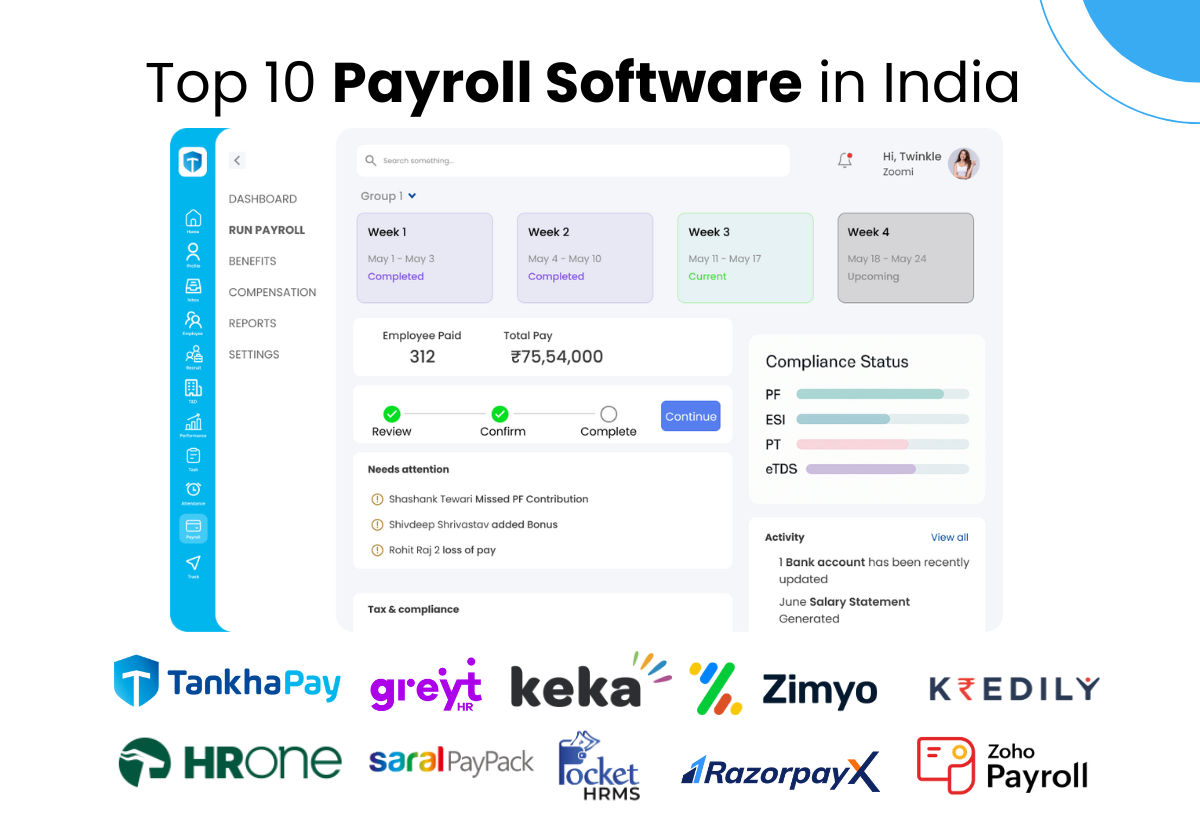Top Payroll Software in India 2025: Features, Compliance & Benefits Guide

In India's vibrant economic ecosystem, where startups in Hyderabad coexist with corporate giants in Delhi, payroll management has transcended its role as a routine task to become a strategic necessity. By 2025, with a workforce surpassing 500 million and the gig economy thriving, effective payroll processing is critical for compliance, employee satisfaction, and operational excellence. Payroll software in India has emerged as the solution, automating everything from salary calculations to statutory filings, enabling HR teams to prioritize talent development over paperwork.
Payroll software refers to cloud-based or on-premise platforms tailored to manage employee compensation while navigating India's intricate regulatory framework, including Employees' Provident Fund (EPF), Employee State Insurance (ESI), and Tax Deducted at Source (TDS). Industry data indicates that 62% of Indian businesses now use cloud-based payroll systems, a jump from 45% in 2020, driven by the demand for remote access and real-time compliance. The shift from manual spreadsheets to AI-driven tools reflects a broader trend toward efficiency and accuracy.
The urgency for robust payroll solutions is amplified by India's evolving labor laws. The four new Labour Codes—Code on Wages 2019, Industrial Relations Code 2019, Code on Social Security 2019, and Occupational Safety, Health and Working Conditions Code 2020—are set for phased implementation starting FY26 for large enterprises. These consolidate 29 laws, introducing protections for gig workers and stricter compliance mandates. Non-compliance risks penalties up to 10% of annual turnover, making payroll software an essential tool for risk mitigation.
This guide explores the landscape of payroll software in India, covering its advantages, critical features, compliance requirements, top solutions for 2025, and a roadmap for selection. Whether you're a startup managing your first 50 employees or an enterprise scaling rapidly, this article offers insights to optimize your payroll processes.
What is Payroll Software in India?
Payroll software in India is a specialized HR tool designed to automate the compensation process, from tracking work hours to generating payslips and filing statutory returns. Unlike generic accounting software, these platforms are customized for India's unique payroll needs, accommodating complex salary structures like House Rent Allowance (HRA), Dearness Allowance (DA), and performance-based incentives.
The evolution from on-premise systems like Tally in the 2010s to cloud-based platforms in 2025 has been transformative. Modern solutions offer mobile access, API integrations with ERP systems (e.g., SAP or Zoho Books), and employee self-service apps. A typical workflow includes syncing biometric attendance, calculating gross-to-net salaries, applying TDS per the latest tax slabs (30% for incomes above ₹15 lakh under the new regime), and enabling direct bank transfers via NEFT/RTGS.
Localization is a standout feature: leading tools support payslips in 22+ regional languages, handle state-specific Professional Tax (PT) variations (e.g., ₹200/month in Karnataka vs. ₹2,500 in Maharashtra), and offer templates for industries like IT (with ESOP modules) or manufacturing (with shift allowances). With India's digital economy projected to reach $1 trillion by 2026, payroll software is integrating with fintech for instant payouts and blockchain for secure audit trails. For multinational firms using Employer of Record (EOR) models, these platforms ensure compliance with both Indian and global standards, such as INR conversions and IFRS reporting.
In short, payroll software in India is more than technology—it's a compliance partner, efficiency driver, and employee engagement tool.
Advantages of Payroll Software in India
Implementing payroll software offers transformative benefits, especially in India's compliance-heavy environment. Here's why businesses are making the switch.
1. Time Efficiency Through Automation: Manual payroll processes can take 20-30 hours per cycle for mid-sized firms, often riddled with errors like incorrect PF deductions. Software automates 80-90% of tasks, including attendance integration, overtime calculations (at 2x rate per Factories Act), and bulk salary disbursals. Tools like RazorpayX Payroll complete salary runs in three clicks, cutting processing time significantly. This allows HR to focus on strategic initiatives, boosting productivity by up to 40%.
2. Precision and Error-Free Processing: Manual TDS miscalculations can trigger employee disputes or tax notices. AI-powered software ensures 99.9% accuracy, managing variables like LTA exemptions or gratuity (15 days' pay per year after 5 years). Real-time error alerts prevent overpayments or underpayments.
3. Cost Savings: While initial costs range from ₹5-₹50/employee/month, the ROI is substantial, with 200% returns from reduced penalties and admin costs. Cloud solutions eliminate hardware expenses and scale effortlessly for seasonal hiring surges.
4. Improved Employee Experience: Self-service portals enable employees to access payslips, request advances, or project taxes via mobile apps, cutting HR queries by 60%. Reliable, transparent payments (99.5% uptime in platforms like greytHR) enhance trust, reducing turnover in sectors like IT.
5. Actionable Insights and Scalability: Analytics dashboards provide visibility into payroll trends, such as overtime costs or pay equity, supporting DEI goals. Scalable platforms handle growth from 10 to 10,000 employees seamlessly.
In a hybrid work era, these benefits are critical, ensuring uninterrupted payroll during disruptions like strikes or natural calamities. Payroll software turns a complex process into a competitive advantage.
Essential Features of Payroll Software in India
Choosing the right payroll software requires evaluating features tailored to India's needs. Here’s what to prioritize:
1. Automated Compliance Handling: Must cover TDS (5-30% slabs), PF/ESI (thresholds at ₹15,000/₹21,000), PT (state-specific), and gratuity/bonus under new Labour Codes. Auto-filings to EPFO/ITR portals save time.
2. Flexible Pay Structures: Support CTC components like basic (40-50%), HRA (50% metro exemption), and incentives. Retroactive processing for mid-month adjustments is critical.
3. Seamless Integrations: Connect with HRMS (e.g., BambooHR), accounting (Tally/QuickBooks), and biometric systems. RazorpayX’s 45+ integrations streamline workflows.
4. Employee Self-Service (ESS): Mobile apps for payslips (15+ formats, regional languages), leave applications, and tax planning, reducing HR workload by 50%.<grok:render type="render_inline_citation">39</grok:render>
5. Advanced Reporting: Custom MIS reports on headcount, compliance, and forecasts, exportable to Excel/PDF for audits.
6. Data Security: ISO 27001/SOC 2 compliance, encryption, and role-based access to protect sensitive data like PAN/Aadhaar post-DPDP Act 2023.
7. Bulk Processing: One-click salary runs for 1,000+ employees, with NEFT/IMPS and loan/advance modules for blue-collar staff.
8. Cloud and Mobile Access: Android/iOS apps and 99.9% uptime for global teams.
9. Custom Workflows: Formula builders for bonuses and AI-driven deadline alerts.
10. Reliable Support: 24/7 chat, vernacular support, and pricing from ₹25/employee for SMBs to enterprise plans.
Opt for platforms like Keka for intuitive ESS or factoHR for retro processing to ensure long-term fit.
Leading Payroll Software Solutions in India for 2025
With over 20 options, we’ve shortlisted seven top platforms based on 4.5+ ratings on G2/Capterra, robust features, and 2025 enhancements.
1. RazorpayX Payroll: Perfect for startups; unique for automating TDS/PF/ESI filings. Pricing: ₹50/employee/month. Pros: Fast disbursals, 45+ integrations. Cons: Limited analytics depth.
2. greytHR: Trusted by SMEs; comprehensive compliance (100+ reports). Pricing: ₹25-₹100/employee. Pros: Mobile-friendly, high accuracy. Cons: Slightly complex interface.
3. Keka: Employee-focused; seamless leave-payroll integration. Pricing: ₹99/employee. Pros: Vernacular payslips, AI previews. Cons: Pricier for small firms.
4. Zoho Payroll: Budget-friendly for small businesses; integrates with Zoho suite. Pricing: Free for <10 employees, ₹249/month up. Pros: Global compliance add-ons. Cons: Limited enterprise features.
5. factoHR: SME-oriented; excels in retro processing, 15 payslip formats. Pricing: ₹30/employee. Pros: Audit-ready, mobile ESS. Cons: Less scalable globally.
6. PeopleStrong: Enterprise-grade; AI-driven attrition insights. Pricing: Custom (₹200+/employee). Pros: End-to-end HR suite. Cons: Setup complexity.
7. Zimyo: All-in-one HRMS; productivity-focused. Pricing: ₹25/employee. Pros: Easy onboarding, scalable. Cons: Fewer reviews as a newer player.<grok:render type="render_inline_citation">0</grok:render>
Select based on business size: RazorpayX for speed, PeopleStrong for enterprise depth.
Selecting the Best Payroll Software in India
Follow these steps to choose wisely:
1. Identify Requirements: Evaluate employee count, industry, and challenges (e.g., multi-state PT compliance).
2. Set a Budget: Balance per-employee costs with add-ons; focus on ROI through time savings.
3. Test with Demos: Try 3-5 platforms; run a sample payroll cycle.
4. Verify Compliance: Ensure readiness for new Labour Codes.
5. Prioritize Support: Choose vendors with 24/7, local-language assistance.
6. Check Reviews: Use G2/Trustpilot for user feedback.
7. Plan for Growth: Opt for cloud-based, scalable solutions.
Start with a 14-30 day trial and ensure secure data migration.
Conclusion
Payroll software in India is a game-changer for businesses navigating 2025’s complex regulatory and economic landscape. By automating processes and ensuring compliance, platforms like RazorpayX and greytHR empower HR teams to focus on growth and employee engagement. With Labour Codes on the horizon, now is the time to invest in a solution that aligns with your needs. Evaluate, test, and implement to turn payroll into a strategic asset. Ready to streamline? Book a demo now.




